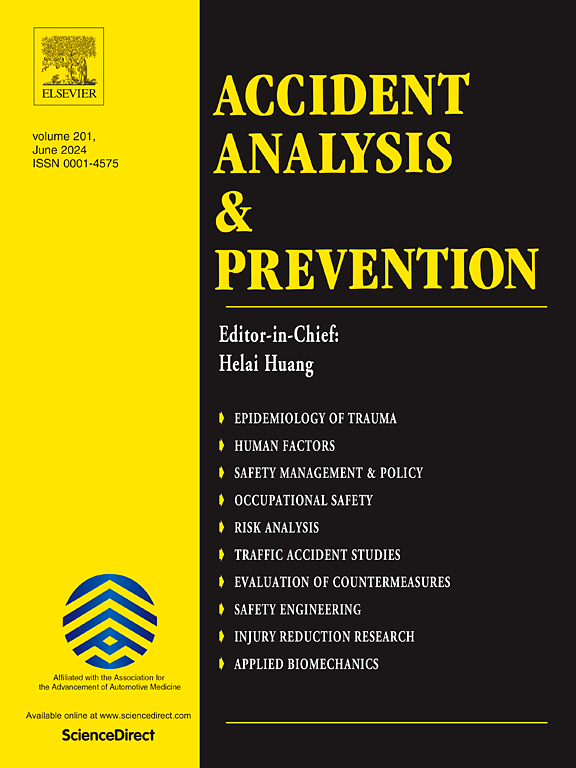Understanding motorcycle crash involvement: Insights from regular motorcyclists and food delivery riders in Vietnam
IF 5.7
1区 工程技术
Q1 ERGONOMICS
引用次数: 0
Abstract
Motorcycles have become a primary mode of transportation in many low- and middle-income countries, including Vietnam, where they are widely used for personal transport and commercial activities. The growing reliance on motorcycles, driven by rapid urbanization and the rise of app-based delivery platforms, has brought economic benefits but also significant public health concerns due to the high incidence of road traffic crashes. This study, based on a questionnaire survey targeting regular motorcyclists and food delivery riders in Vietnam, examines and compares the factors contributing to crash involvement between two groups, regular and delivery riders. Random parameters models with heterogeneity in means and variances were employed to capture variability in respondent behaviors. The results reveal that psychological factors, such as negative attitudes toward traffic rules and intentions to violate rules, significantly increase crash involvement for both regular and delivery riders, with the effect being more pronounced among delivery riders due to job pressures. Conversely, positive attitudes reduce crash involvement but are less effective for delivery riders due to high time pressures and frequent distractions. Perceived severity of crashes and the swiftness of sanctions also play critical roles: higher perceived severity promotes safer behavior, while the threat of sanctions deters risky actions for both groups. Rider attributes, such as age, education, and income, influence crash involvement, with younger and lower-educated riders facing higher risks among both groups due to inexperience and limited traffic knowledge, while income effects vary between regular and delivery riders. Travel characteristics, such as travel durations of more than two hours, increase crash involvement due to fatigue and exposure, particularly affecting delivery riders who navigate complex urban environments and face frequent distractions. The findings also highlight the importance of addressing heterogeneity in data analysis for more comprehensive insights. Moreover, based on these results, various policy implications are provided to reduce traffic crashes and enhance safety for motorcyclists in motorcycle-dominated countries.
了解摩托车事故参与:来自越南普通摩托车手和送餐员的见解
摩托车已成为包括越南在内的许多低收入和中等收入国家的主要交通方式,在那里摩托车被广泛用于个人交通和商业活动。在快速城市化和基于应用程序的交付平台兴起的推动下,人们越来越依赖摩托车,这带来了经济效益,但由于道路交通事故的高发生率,也带来了重大的公共卫生问题。本研究基于一份针对越南普通摩托车手和送餐骑手的问卷调查,研究并比较了两组人——普通摩托车手和送餐骑手之间导致撞车的因素。采用均值和方差异质性的随机参数模型来捕捉被调查者行为的可变性。结果表明,对交通规则的消极态度和违反交通规则的意图等心理因素显著增加了快递员和普通快递员的碰撞卷入,而由于工作压力的影响,快递员的影响更为明显。相反,积极的态度减少了事故的发生,但由于时间紧迫和经常分心,对快递员来说效果不太好。感知到的事故严重程度和制裁的快速性也起着关键作用:感知到的严重程度越高,行为越安全,而制裁的威胁对两组人来说都能阻止危险行为。骑手的属性,如年龄、教育程度和收入,会影响车祸的发生。由于经验不足和交通知识有限,年轻和受教育程度较低的骑手在这两个群体中面临更高的风险,而收入的影响在普通骑手和快递骑手之间有所不同。旅行的特点,比如旅行时间超过两小时,由于疲劳和暴露,会增加车祸的发生几率,尤其是对那些在复杂的城市环境中穿行、经常分心的送货员来说。研究结果还强调了在数据分析中解决异质性的重要性,以获得更全面的见解。此外,根据这些结果,提出了在摩托车占主导地位的国家减少交通事故和提高摩托车手安全的各种政策建议。
本文章由计算机程序翻译,如有差异,请以英文原文为准。
求助全文
约1分钟内获得全文
求助全文
来源期刊

Accident; analysis and prevention
Multiple-
CiteScore
11.90
自引率
16.90%
发文量
264
审稿时长
48 days
期刊介绍:
Accident Analysis & Prevention provides wide coverage of the general areas relating to accidental injury and damage, including the pre-injury and immediate post-injury phases. Published papers deal with medical, legal, economic, educational, behavioral, theoretical or empirical aspects of transportation accidents, as well as with accidents at other sites. Selected topics within the scope of the Journal may include: studies of human, environmental and vehicular factors influencing the occurrence, type and severity of accidents and injury; the design, implementation and evaluation of countermeasures; biomechanics of impact and human tolerance limits to injury; modelling and statistical analysis of accident data; policy, planning and decision-making in safety.
 求助内容:
求助内容: 应助结果提醒方式:
应助结果提醒方式:


